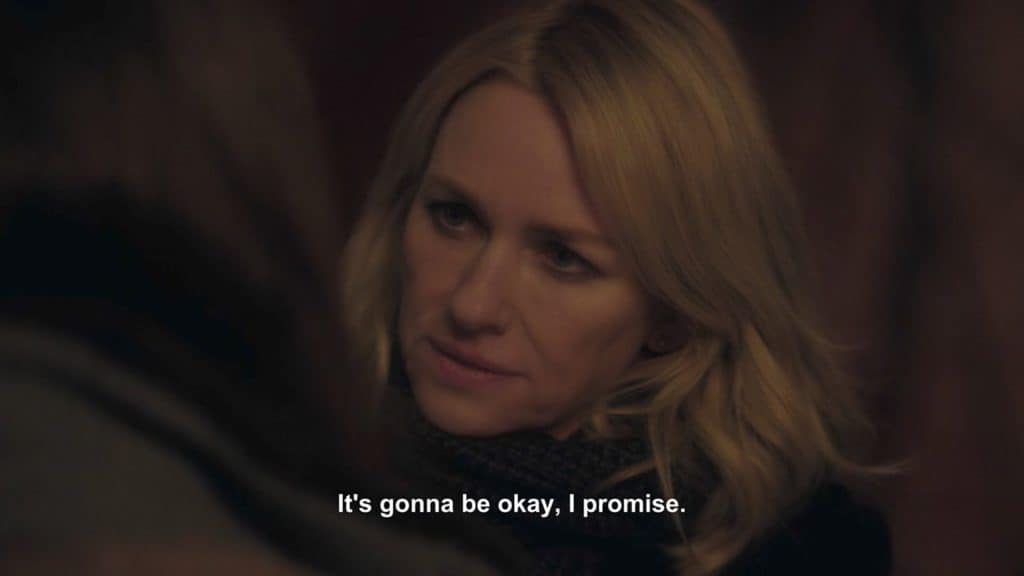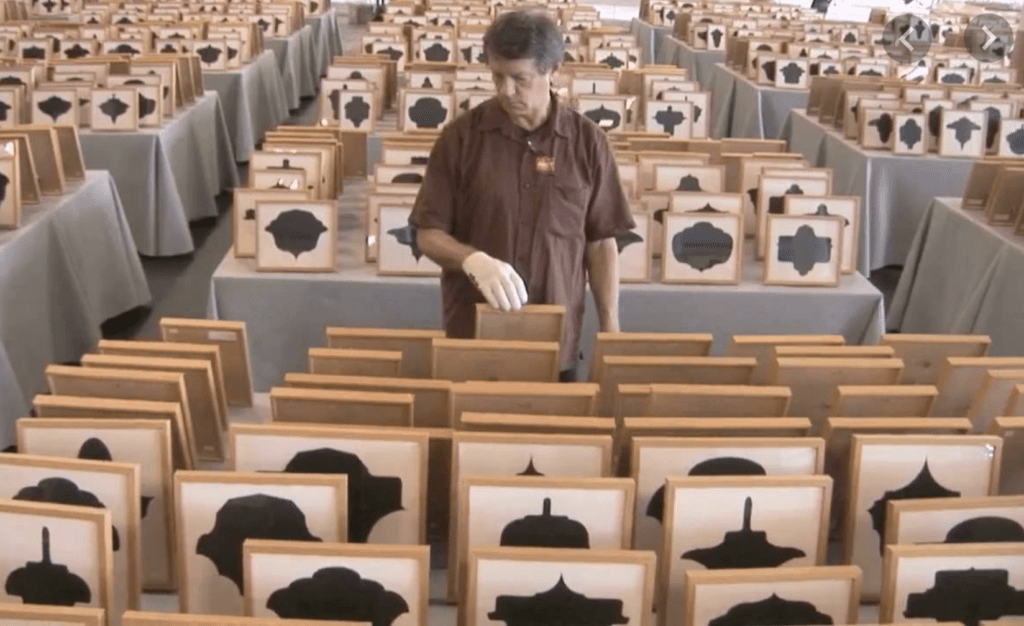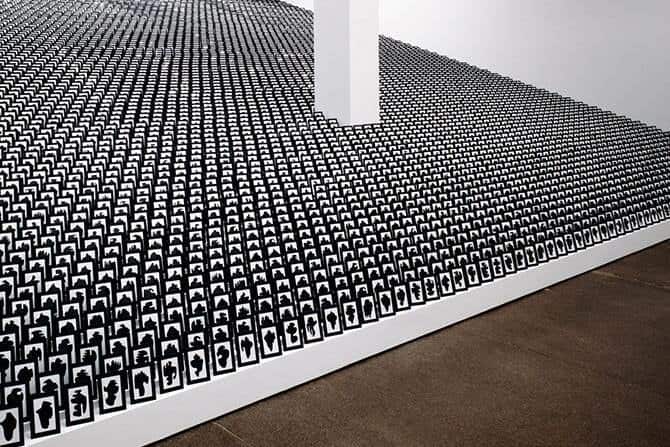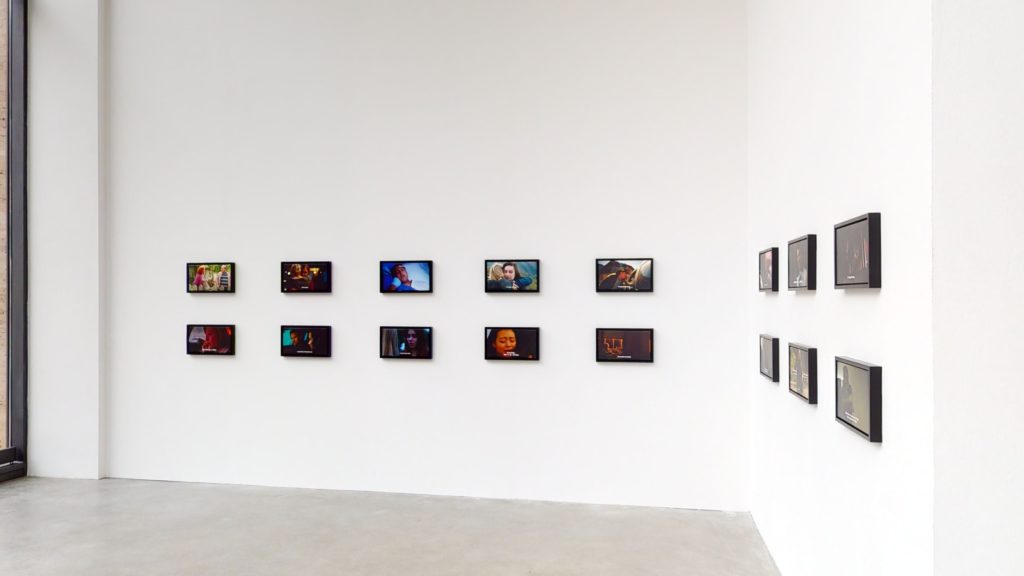Articles and Features
“Everything Is Going To Be Ok”
Allan McCollum offers comfort and consolation at Galerie Thomas Schulte in Berlin

Currently on display at Galerie Thomas Schulte in Berlin is an installation of works by Allan McCollum, who, for over 50 years, has produced remarkable bodies of work that explore the intersection of labour and art, methods and systems of quantity-production, and how meaning is contained in an artwork in a world where the mass produced dominates. The works consist of film stills, called screengrabs, taken from his image archive An Ongoing Collection of Screengrabs with Reassuring Subtitles, which at the present time consists of 1,200 screenshots from American TV series and movies. Each shows protagonists receiving comfort and characterised by subtitles such as “It will be ok”, “Everything’s alright”, or “Don’t worry, Babe”.
This group of works is especially designed for Galerie Thomas Schulte to be offered to friends, supporters and interested clients as a sign of consolation and to financially help two highly acclaimed art institutions, the ICA Miami and C/O Berlin Foundation, to cope in these difficult times, who between them will receive 30% of sale proceeds. A selection of the works will be shown at the gallery in an individual exhibition until July 11, 2020. For this installation McCollum has chosen 400 such motifs to be printed on canvas, each unique, framed in black wood and measuring 10.4 x 17.2 x 1.6 in (26.3 x 43.8 x 4 cm) and available for the incredibly reasonable price of €700 apiece.
Browse and acquire available works here & here
McCollum began this project in 2015 as a visual essay about the meaning of closeness and comfort in our society. He wants it to serve as a reminder that it is through the telling and sharing of stories that we perceive the world. It is also a critique of Hollywood and populist rhetoric which assuages fear by promoting the narrative of a hero coming to the rescue, while in reality we depend on being part of a community of family, friends, neighbors and colleagues for this kind of succour. All of the screenshots from films and movies amassed by McCollum depict people in situations of great uncertainty and distress being comforted with words of support that are spelled out in the subtitles. But while anxiety and worry are feelings that are individually and subjectively felt and experienced by all of us, the encouraging phrases on the screen through endless repetition soon become somewhat meaningless. We asked Allan for his thoughts on this series, and how he considers it within his wider body of work.
“And I feel that at a certain point we all need to question ourselves, and make decisions based on what’s real, rather than what we imagine”
Artland: Hello Allan, thank you for talking about these works with us. How did the idea for this exhibition and benefit component come about? This work deals with themes of human closeness, focusing on empathy, consolation and comfort. It feels like it has an antidote quality to recent traumas. Do you hope it offers some kind of timely balm?
Allan McCollum: I began the project simply as a website, I’ve been adding images to it for close to six years. I had just turned 70 back then, and my hearing had begun to slowly deteriorate somewhat, and I needed hearing aids. But even with the hearing aids, I had a hard time understanding what people were saying when I was watching movies on my computer, so I chose to watch TV shows and movies using subtitles. As time went by, I began to notice how often people said to one another things like, “Everything’s going to be OK,” “No need to worry,” You’re going to be fine,” and things like that. Characters reassuring one another. It began to astonish me how often these lines were used in stories. And I began to think about the stories we all hear as children, fairy tales and so on, where everyone “lives happily ever after.” It’s how we are taught to think about life. It’s a part of our culture. And I started to think about the writing of Vladimer Propp, in his book “The Morphology of the Folk Tale.” We are taught as children to feel that everything is going to be ok in the end. And this feeling resides in the backs of our minds all through adulthood. But in one’s old age, like mine, I guess questions about this undercurrent of belief began to arise. And I feel that at a certain point we all need to question ourselves, and make decisions based on what’s real, rather than what we imagine.
[ If interested, some of Propp’s writing is here
And a simple list of his “functions” here )

You are known for producing massive samples of works, where each piece is unique but formulated by a set of fixed conditions and modular elements, and also for paying close attention to the meaning and implication of quantity. How do you conceive of this body of work in that context?
It was the quantity of times that characters in TV shows and film use phrases like this that stunned me. Over and over. I guess that might have connected with me and my love of large quantities. And it also taught me how often we need to be reassured about how things will turn out. We say things like this to each other over and over and over, apparently. And somehow, subtitles in films make this really obvious.
Your various projects or series seem to inform the next and later series of works as one large continuum. As an example the Shapes Project was conceived as a system to produce “a completely unique shape for every person on the planet, without repeating” and also here in these screenshots we obviously see a wide cross-section of people. Do these actual human figures represent everyman or universal exemplars just as the shapes do, but in a more literal way?
I think so, yes. All cultures are different, of course. Propp’s writings were only about Russian fairy tales. But it seems pretty obvious that the stories we tell our children have this feature throughout most all cultures.

Installation: Friedrich Petzel Gallery, New York
Some of the screenshots are quite poignant in the scenes they represent, but the endless repetition across the installation dilutes the potency of the individual pieces and moves towards the banal. How much did you look at the individual scenes themselves? And how much is the project about an overarching totality, about how tv shows communicate with us through these kinds of clichés? It seems as if the project might be celebratory of tenderness but also simultaneoulsy cynical or critical?
There is a wide range of plot points in the films that generate these kinds of verbal exchanges. Yes, one could think of the comments as clichés . . . but language is filled with repetitiousness, no? Like, “I love you,” “Have a good day,” “Sleep well,” and so on.
And the scenes themselves, was the freezing of the frame so conceived merely to contain the ’necessary’ subtitle verbiage, or did you look for any compositional qualities in the scene itself as a photographer or cinematographer might?
I don’t think so, I just jumped to take a screenshot when the subtitle appeared.
You are known for works that function as props for paintings and have talked about your relationship to painting, saying in prior interviews that “When I first decided to be an artist, I was interested in exploring self-referential angles on how our culture defines a “painting.” I quickly realized that a painting is ultimately defined by its context. And all contexts are within other contexts within other contexts, so I’m always drawn into an ever-expanding idea of contexts….When I became an artist, I thought that meant being a painter. I didn’t go to college or art school, so no one ever taught me any different.” Does the above explain why you decided to print these photographic images onto canvas and then frame them in this way? What about this object quality is important to you here?
Maybe! But probably not. I designed the project as a website, it was kind of a hobby for me, sort of a self-evaluation. The idea of making physical “objects” of the images developed out of a conversation I had with Thomas Schulte. We realized it was a time for everyone to be thinking about staying safe, and to question some of our preconceptions about how things might turn out.
And now a more playful question. We can recognise many characters from tv series or shows we have seen. Was there a specific criteria for selecting a show to screenshot? An idea where a sort of low brow entertainment could be transfigured into a more high brow form? Or are they simply shows that you have watched?
Purely shows that I watched, depending on my moods at the time! There was no specific criteria. I like to watch movies and TV shows on my laptop just to calm myself, to relax. I’ve always liked movies since I was a child!

You can pay a visit to the exhibition at Galerie Thomas Schulte in Berlin, Charlottenstrasse 24 until July 20th, or can visit a 3D recording of the installation above. Please generously support the benefit initiative by acquiring works either at Galerie Thomas Schulte’s designated webshop here or directly from Artland.
Relevant sources to learn more
Michael Bevilacqua – Studio Visit and Interview
See available works by Allan McCollum at Galerie Thomas Schulte
See available works by Allan McCollum at Artland